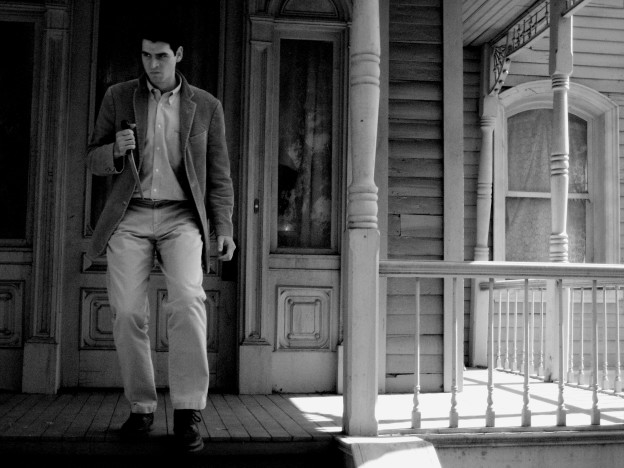Warning: Please Be Advised That This Article Contains Graphic Content
The Making of Eddie Gein – The Real Life Psycho and Inspiration for the Character Norman Bates
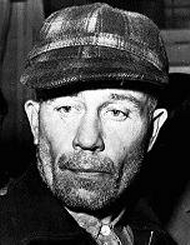
Edward Theodore Gein was born to George and Augusta Gein on August 27, 1906 in La Crosse, Wis. With a brother who was 7 years his senior, Eddie was the baby of the family. Augusta was a domineering and extremely religious woman. She was convinced that her views were absolute and true. She raised her boys with a strict moral code, continuously warning them of the dangers of immoral and loose women: Her hope was to discourage her boys from giving in to their sexual desires due to their fear of being cast into the depths of hell.
Oh Father, Wherefore Art Thou?
George Gein was a drunkard. He had no part in how the boys were raised: To Augusta, George was worthless and weak because he was unable to retain employment, let alone care for the boys. For this reason, Augusta raised the boys according to her extreme religious beliefs. She sustained the family financially through a grocery business. She was not afraid of hard work and she began saving money in the hopes of moving her family away from the city as she considered it an immoral place that was full of sinners.
The Plainfield Farm – 195-Acres of Loneliness
When Eddie was 8 years old, the family moved onto a 195-acre farm in Plainfield, Wis. The nearest neighbors were approximately one-quarter of a mile away. Eddie’s schoolmates avoided him because he was timid and had a feminine disposition; therefore, he had no friends. When Eddie tried to make friends, his mother scolded him. He personified his mother, considering her the epitome of goodness and did his best to follow all of her orders. Even so, Augusta verbally abused the boys; furthermore, pleasing her was a rarity. Henry and Eddie remained detached from the outside world until they reached early adulthood.
Henry and Eddie Considered Trustworthy, Reliable Men
Eddie admired his brother: He considered Henry a hard-working man with a strong character. Following their father’s death in 1940, Eddie and Henry worked odd jobs to assist in supporting their mother and the farm. Eddie did his best to emulate the work habits of his brother. The townspeople considered them both to be trustworthy, reliable men. Although the two frequently worked as handymen, Eddie also babysat for the neighbors’ children. He enjoyed babysitting because he found it easier to relate to the children than to his peers: In many ways, Eddie Gein was emotionally and socially retarded.
Eddie’s Attachment to His Mother Causes Friction
Henry voiced concerns about Eddie’s obsession with their mother. Henry was not afraid to openly criticize Augusta, which shocked Eddie. He was horrified that Henry did not view their mother as pure goodness: Some believe that this disagreement may be what led to Henry’s mysterious, untimely death.
The Death of Henry Gein – May 16, 1944
A brush fire was burning close to the farm. As Henry and Eddie fought the fire, they separated, heading in different directions. According to the police report, as night approached Eddie lost sight of his brother. Once the blaze was contained, Eddie became concerned about Henry and contacted law enforcement. Prior to arriving at the farm, the police organized a search party; however, no search party was necessary because Eddie led police directly to the body of his missing brother. Some of the circumstances surrounding Henry’s death did not make sense. For instance, the piece of ground where Henry lay was free of fire damage and there were visible bruises on his head.
Strange Circumstances – Quickly Dismissed
Even though strange circumstances surrounded Henry’s death, no one believed that Eddie could kill someone, let alone his own brother. Eventually, the coroner listed Henry’s cause of death as asphyxiation.
December 29, 1945 – The Breaking of Eddie Gein
Augusta Gein passed away following a series of strokes on Dec. 29, 1945. Eddie realizes that with the death of his mother, he has lost his only friend and the love of this life. Now, Eddie had no one.
He stayed at the family farm and worked odd jobs to sustain himself. He closed off the rooms in the house where his mother spent most of her time. These areas included the entire upstairs, the living room and downstairs parlor. He preserved these rooms leaving them untouched as a shrine to his mother.
Dark Hobbies
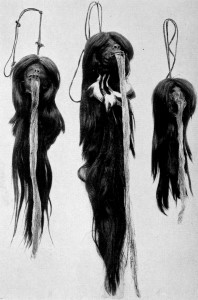
For Eddie Gein, an Obituary Brought with It an Opportunity
Gein enjoyed reading the obituaries and then visiting the graves of the recently deceased women he read about in the obituary. Since Gein never had the opportunity to enjoy the company of a woman, he quenched his lust when he visited the graves under the cover of darkness. Eddie claims that he never had intercourse with the women he exhumed because “they smelled too bad.” However, he did peel off their skin and wore it. He wanted to know what it would be like to have female body parts and he frequently dreamed about being a woman.
Eddie Gein – The Collector
As time passed, Eddie’s collection of body parts continued to grow. A young boy that Gein would occasionally look after stated that Eddie showed him the human heads that he kept in his bedroom: He told the boy that the shriveled heads were relics from headhunters. The boy’s story was dismissed as a figment of his imagination: That is, until two more young men stated that they too saw the preserved heads. The boys thought that the heads were just some kind of strange Halloween costume. Rumors circulated and townspeople began gossiping about Eddie’s supposed collection of human heads. Even so, no one took these accusations seriously.
Missing Persons in Wisconsin On the Rise
From the late ‘40s and ‘50s Wisconsin law enforcement noticed an increase in the number of missing persons’ cases.
Police were bewildered by four cases in particular:
- 1947 – 8-year-old Georgia Weckler disappeared as she walked home from school in her town of Jefferson, Wis. Police and hundreds of townspeople searched Jefferson for the little girl, to no avail. Sadly, she was never seen again. The only evidence the police had were tire marks that belonged to a Ford.
- 1952 – Ray Brugess and Victor Travis were headed out for a deer hunt when they decided to stop in for a drink at a tavern in Plainfield, Wis. After spending several hours at the tavern, the two left. Burgess, Travis, their dog and the car were never seen again.
- 1953 – 15-year-old Evelyn Hartley disappeared in La Crosse, Wis. At the time she vanished, she was babysitting. Evelyn’s father tried to call her repeatedly at the home where she was babysitting. He was never able to reach her; therefore, out of concern he drove to the home. No one answered the door, he saw a pair of glasses and Evelyn’s shoe on the floor. All the windows and doors were locked; that is, except the basement window which was speckled with bloodstains. He immediately entered the home where he found signs of a struggle: He contacted the police. When the police arrived, they found blood stains on the grass that led away from the home. Evidence included a bloody handprint on a neighbor’s house, footprints and Evelyn’s other shoe lie on the basement floor. Several days later, Evelyn’s bloodied clothing was discovered close to a highway outside of La Crosse.
- 1954 – Mary Hogan, a Plainfield barkeep disappeared from her tavern. Foul play was suspected when police discovered blood on the floor of the tavern that led into the parking lot. In addition, an empty bullet cartridge lay on the floor.
All four of these cases perplexed police because there was very little evidence and no bodies to be found. The only common tie was that these disappearances occurred in or around Plainfield, Wis.
The Disappearance of Bernice Worden
Gein was suspected of robbing the local hardware store; in addition, Bernice Worden, who owned the store, had disappeared. He was the last customer at Worden’s store. Furthermore, Eddie had been seen hanging around near the store thereafter. These suspicions prompted the police to visit his farmhouse.
On Nov. 17, 1957 Eddie Gein’s Pastimes Are Discovered
The Gein farmhouse floor was covered with rotting garbage. The smell of decomposition and filth hung heavy in the air. Just trying to walk through these rooms was nearly impossible. Sheriff Arthur Schley was using a flashlight to inspect the kitchen when he suddenly felt something brush against his jacket: He looked up and saw a carcass dangling from the ceiling beams. Initially, he thought the caucus was that of a deer; however, he soon realized that it was the body of a woman. A woman by the name of Bernice Worden, who was the mother of Deputy Frank Worden.
Following the discovery of Bernice Worden, the officers continued searching through the home: They were horrified by what they found. They found A bowl made from the top of a skull and items made of, or covered with human skin.
- A wastebasket
- Lampshades
- An armchair
- An entire bodysuit
- A belt constructed of areolas, nipples and the skin that surrounds them
Some of the other items found include:
- A human head
- Four noses
- A heart
- Female genitalia
The Interrogation
As Eddie spoke with investigators about the murders, he showed no signs of negative emotion or remorse; however, he did speak bluntly about the incidents and even seemed cheerful at times.
Eddie Admits to the Murder of Bernice Worden and Mary Hogan
Although the police tried desperately to implicate Gein in the disappearance of the four other people who vanished in and around Plainfield, initially, Eddie would only admit to the murder of Worden; however, he does eventually admit to murdering Mary Hogan as well.
Eddie Gein’s Psychological Evaluation
A suggestion was made that Gein should plead not guilty, by reason of insanity, which led to Eddie succumbing to a variety of psychological tests. Needless to say, these tests concluded that Eddie Gein was emotionally impaired. The professionals who interviewed Eddie diagnosed him with schizophrenia and labeled him as a sexual psychopath. They attributed Gein’s condition to his unhealthy relationship with his mother as well as his upbringing.
Conflicting Feelings About Women Led to Gein’s Psychosis
Not surprisingly, Gein had conflicting feelings when it came to women. He was sexually attracted to them, but the unusual attitudes instilled in him by his mother caused him to have love/hate feelings towards women. These feelings eventually became exaggerated, evolving into full-blown psychosis. All in all, the remains of 10 women were discovered within the Gein farmhouse. Eddie claimed that many of the remains were gathered when he visited the cemetery. After much debate, the police exhumed the bodies of the women that Gein stated he took body parts from: Police did find that body parts were missing from the women they exhumed.
The Media
Once information about Eddie Gein became public, psychologists around the world tried to determine what caused Eddie to perform such heinous acts. In the ‘50s, Gein gained notoriety as one of the most famous cases that involved a combination of transvestism, necrophilia and fetishism.
The majority of residents who actually knew Eddie had only positive things to say about him; although they did admit that he was a little different, he had a strange sense of humor and a quirky grin. No one who knew him ever suspected that he was capable of such grisly crimes.
Children Use Humor to Deal with Gein’s Exploits
According to Harold Schechter, who authored the book Deviant, the reason that children made up songs and jokes (referred to as Geiner’s) about the horrific acts performed by Eddie Gein was to exorcise the nightmare through laughter. These repugnant jokes became popular all around the globe.
The Mental Institution
Eddie Gein spent 30 days in a mental institution; after which, he was deemed mentally incompetent. Therefore, Eddie could not be tried for first degree murder. The residents of Plainfield were enraged at the fact that Gein was not going to be tried for the murder of Bernice Worden; instead, he was sent to the Central State Hospital located in Waupun, Wis. The Gein farm and some of Eddie’s personal belongings went up for auction shortly after he was committed to the mental institution.
The Auction Company Enrages Plainfield Residents
Curiosity seekers came to the auction to see what items were up for sale. The company handling the auction began charging an entrance fee to see Eddie’s property. The residents believed that the Gein farm was becoming a museum for the morbid, demanding that this practice of charging an entrance fee be halted immediately. Eventually, the company was forbidden to charge the entrance fee; however, the citizens of Plainfield were still unhappy.
The Gein Home Goes Up in Flames
On March 20, 1958, Plainfield’s Volunteer Fire Department received a call that the Gein house was in flames. As onlookers viewed its destruction in silent relief, the home quickly turned into a pile of ash. Police were convinced that the fire was started by an arsonist, as there were no electrical wiring problems within the home to speak of. Despite a thorough investigation, a suspect was never identified.
When Eddie was informed of the fire, he stated, “Just as well.” The possessions that did remain were auctioned off, one of which was Eddie’s 1949 Ford Sedan. The car he used to move corpses and body parts around. After a bidding war, the car sold for $760. The man who bought the vehicle displayed it at a county fair, charging a quarter to fairgoers who wanted to view “Gein’s Ghoul Car.”
After 10 Years in the Mental Institution – Gein Considered Competent Enough to Stand Trial
On Jan. 22, 1968, proceedings began to determine whether Eddie was guilty for the murder of Bernice Worden: He could still be found not guilty by reason of insanity.
The trial began on Nov. 7, 1968. One by one witnesses took the stand to discuss Bernice Worden’s autopsy findings and the numerous pieces of evidence found at Gein’s home. There was a substantial amount of evidence stacked against Eddie and the judge found him guilty of first-degree murder; however, he was deemed to be insane when the killing occurred, which led to a later verdict of not guilty by reason of insanity. Eddie was acquitted and soon thereafter he was escorted back to the mental hospital.
A Model Patient
Eddie remained at the mental hospital until the end of his life. He was said to be a model patient who was happy living at the hospital. Although he had no problem getting along with the other patients, he tended to keep to himself most of the time. He had gained a substantial amount of weight because he was eating three meals a day. He enjoyed chatting with the psychologists and completing his occupational therapy projects.
Eddie Gein was one of the few patients within the hospital who did not require tranquilizers to keep his insane thoughts under control. In fact, except for the way he stared at female staff members who roamed into his sight path, recognizing Gein as an insane patient was difficult. According to Superintendent Schubert, if all the patients at the mental hospital were like Eddie, there would be no trouble at all.
The Death of Eddie Gein
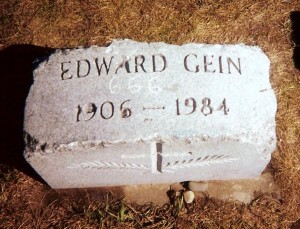
Above is an image of Ed Gein’s headstone as it appeared back in 1999. Do you see the ‘666’ carved in the center?
On July 26, 1984, Eddie died of heart and respiratory failure related to cancer. Eddie Gein was buried next to his mother in the Plainfield cemetery, rather close to the graves he had exhumed years earlier. Throughout the years, Eddie’s grave site was vandalized and individuals would visit his grave to chip pieces off of his gravestone to keep as souvenirs. In 2000, the bulk of the gravestone was stolen; however, it was recovered in 2001. It now sits in a museum located in Waushara County.
Fictional Characters Inspired by Eddie Gein
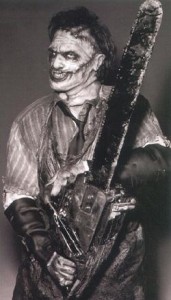
These characters include:
- Leatherface from “The Texas Chainsaw Massacre”
- Buffalo Bill from “The Silence of the Lambs”
- Norman Bates from “Psycho”
Other Movies and Musicals Created Using Eddie Gein’s Life Story as Inspiration:
- 1974 – “Deranged”
- 2000 – “In the Light of the Moon” (retitled “Ed Gein”)
- 2007 – “Ed Gein: The Butcher of Plainfield”
- 2010 – A biographical musical in Menasha, Wis. entitled “Ed Gein: The Musical”
The story of Eddie Gein is an example of the impact parents can have on their children. I am sure that Augusta meant well; however, sometimes our own obsessions with perfection and supreme morality confuse our children; thus, causing them to spiral into a place exactly the opposite of what we tried to instill in them.
- https://en.wikipedia.org/wiki/Ed_Gein
- Serialkillercalendar.com
- http://murderpedia.org/male.G/g/gein-edward.htm
- http://www.biography.com/people/ed-gein-11291338
- http://www.wisconsinsickness.com/ed-gein/
- http://murderpedia.org/male.G/g/gein-edward.htm
- http://charleyproject.org/cases/h/hartley_evelyn.html
- http://charleyproject.org/cases/w/weckler_georgia.html
- http://maamodt.asp.radford.edu/Psyc%20405/serial%20killers/Gein,%20Ed.pdf
- http://www.history.com/this-day-in-history/real-life-psycho-ed-gein-dies

